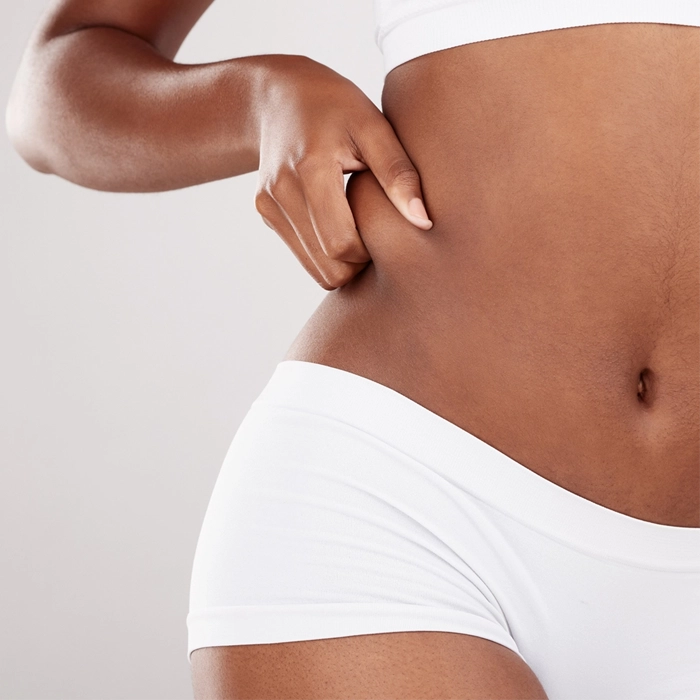Fat transfer is also known as fat grafting or autologous fat transfer. It involves the transfer of excess fat from one area of the body to another to enhance volume, contour, and rejuvenate the target area. The procedure typically consists of three main steps: fat harvesting, fat processing, and fat injection.
Fat harvesting is performed using a thin, hollow tube called a cannula, which is attached to a suction device. During the procedure, a small incision – about 3-4mm – is made in an inconspicuous donor area such as the abdomen, thighs, or flanks. The cannula is then inserted through the incision and used to suction out an excess fat deposit. Care is taken to help ensure the fat is harvested evenly and in a manner that minimizes trauma to the surrounding tissues.
Once harvested, the fat is processed to remove excess fluid before it can be reinjected into the target area. This is typically done using a filtration system to separate the fat cells from other components. The purified fat is then transferred to syringes for injection.
Once in a syringe, the fat is ready to be injected. Fat injection involves carefully and precisely injecting the processed fat into the target area using specialized blunt tipped cannulas. Smaller cannulas are utilized on the labia majora, breasts, and face (compared to large volume fat transfer in a Brazilian Butt Lift).
For people wanting the results of fat grafting without the downtime of a surgical procedure with general anesthesia, some patients may opt for Renuva or Leneva fat matrix injections which have minimal downtime.

With proper postoperative care and maintenance, the results of fat transfer procedures can be long-lasting and provide natural-looking enhancements. However, if you lose weight, you will lose weight everywhere – including the areas injected with fat during your fat transfer.
It’s also important to note that there will be some degree of fat resorption in first weeks and months post op. Assuming compliance with post-operative instructions, most adults maintain about 50-75% of the injected fat, depending on age and medical history. To optimize outcomes and minimize the effects of fat resorption, Dr. Desrosiers will consider the patients age and their medical conditions to determine how much fat should be injected to account for anticipated fat resorption.

Some of the common areas that can be treated with fat transfer include:
Fat transfer to the labia majora can augment and rejuvenate the outer vaginal lips, improving symmetry, size, and contour. The natural process of aging results in loss of collagen, elastic, and fat over time. This aging process occurs not only in the face and hands, but also in the labia majora. Fat grafting can also be performed to augment the outer vaginal lips to give the optical illusion that the labia minora are smaller (without actually performing any invasive surgical procedure on the inner lips).
For certain patients that prefer to avoid additional liposuction and fat grafting surgeries, our practice offers the latest cutting-edge technology—specifically, Renuva® and Leneva® fat matrix injections. Note that Renuva or Leneva injections can be performed in the labia majora and offer a long-term solution because the which the injectable fat matrix is resorbed leaving the patient’s own naturally grown fat in its place. Our practice has several female physician assistant injectors who have been trained (by Dr. Desrosiers) to perform fat injections for labia majora augmentation.

Fat transfer can also be used to fill in depressed scars and areas of volume loss on the body, such as those resulting from trauma, surgery, or congenital conditions. For certain patients that prefer to avoid additional liposuction and fat grafting surgeries, our practice offers the latest cutting-edge technology—specifically, Renuva® and Leneva® fat matrix injections.
Fat transfer to the face can restore lost volume, fill in wrinkles and lines, and rejuvenate facial contours. It is often used to enhance areas such as the cheeks, temples, under-eye hollows, lips, and nasolabial folds.
Fat transfer to the breasts, also known as natural breast augmentation, can increase breast size and improve shape without the use of implants. Note, fat transfer to the breast can affect mammography. This is because the body may not fully absorb the 25-50% of transferred fat that does not live. While any remaining particles are unnoticeable to the patient, they may appear similar to calcifications on mammography. For this reason, Dr. Desrosiers often recommends Renuva or Leneva injections which might pose less risk of affecting mammography because the injectable fat matrix is resorbed leaving the patient’s own naturally grown fat in its place.
Fat transfer to the buttocks, commonly referred to as a Brazilian Butt Lift (BBL), can enhance buttock size, shape, and projection. It involves transferring fat from donor areas to the buttocks to create a more rounded and lifted appearance.
Fat transfer to the hands can rejuvenate the appearance of aging hands by adding volume, smoothing wrinkles, and concealing prominent veins and tendons. The fat is injected just under the skin in the subcutaneous plane with a small blunt tipped cannula. For certain patients that prefer to avoid additional liposuction and fat grafting surgeries, our practice offers the latest cutting-edge technology—specifically, Renuva® and Leneva® fat matrix injections. Renuva or Leneva injections can be performed on the dorsum of the hands and these injections offer a long-term solution. This is because the injectable fat matrix is resorbed over several months leaving the patient’s own naturally grown fat in its place.
Whether you’ll need compression garments depends on how much fat is harvested. Generally, compression garments are needed because patients want more than a minimal amount of liposuction for aesthetic reasons. Post-liposuction compression garments serve multiple purposes in the recovery process. First, compression garments provide essential support to the treated areas, aiding in the stabilization of tissues and minimizing the risk of postoperative complications. Additionally, they play a crucial role in reducing swelling by applying gentle pressure to the treated areas, which helps to facilitate fluid drainage and promote tissue healing. Moreover, compression garments promote skin retraction, helping ensure that the skin conforms smoothly to the newly contoured body shape. By offering consistent and controlled compression, these garments contribute to shaping the body’s contours and optimizing the overall aesthetic results of the procedure.

This too depends on how much fat is harvested for the fat transfer. If lipo massage (also called lymphatic massage) is recommended, patients typically have a series of at least 12 sessions typically starting several days post procedure. These specialized massages are gentle and specifically targeted to promote lymphatic drainage, which plays an important role in reducing postoperative swelling and preventing the formation of irregularities and/or scar tissue (sometimes called fibrosis) in the treated areas. By facilitating lymphatic circulation, these massages contribute to optimal healing and enhance the overall outcomes of the procedure.

Dr. Desrosiers understands that each patient is unique and requires individualized care. With his expertise and dedication to achieving exceptional results, Dr. Desrosiers is committed to guiding you through your fat transfer journey with confidence and support.
To learn more about our fat transfer procedures or to schedule a consultation with Dr. Desrosiers, please contact us at 305-403-2922 or concierge@ArthurMD.com. Let Dr. Desrosiers help you achieve the body of your dreams with advanced body contouring techniques and personalized care.

Providing Cosmetic, Reconstructive, & Craniofacial Plastic Surgery in Miami and West Palm Beach.